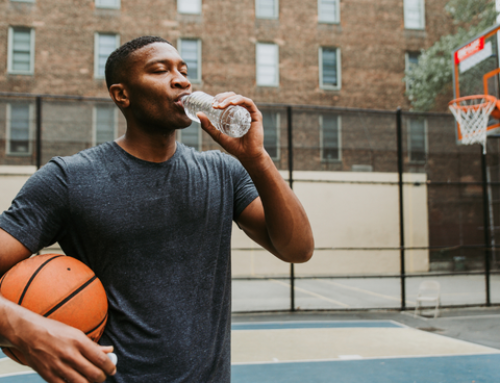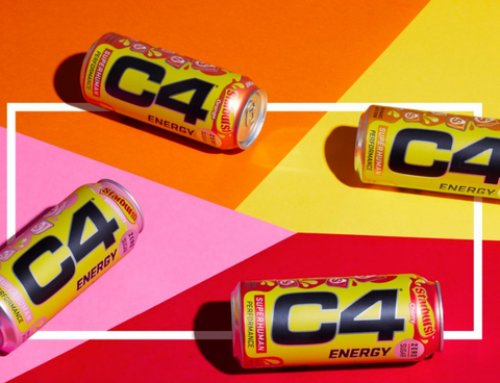Raising a Red Flag on Some Energy Drinks
Energy drinks have enjoyed a surge in popularity in recent years. Beverage Digest estimates that the market for these products is now a $7.7 billion industry.1 Yet despite their increasing popularity, controversy still exists about the safety and suitability of these beverages for daily use; and many people don’t realize the danger that some of them can pose. Several states have attempted to pass legislation banning the sale of such drinks to minors. Although no bills have passed, they served as a warning to manufacturers.
If you choose to consume energy drinks, it’s important to educate yourself about them—both what they do and their possible side effects.
Energy Drinks vs. Sports Drinks
It’s important not to confuse energy drinks with sports drinks, which are intended to re-hydrate the body. Sports drinks such as Gatorade both provide sugars, which the body burns to create energy, and replenish electrolytes, which helps to maintain sodium and potassium balances in the body. Energy drinks containing large amounts of caffeine produce the opposite effect, causing dehydration, which can lead to fatigue, increase body temperature and heart rate, and potentially place an individual in a compromised position for performance. This is true for weekend warriors, active fitness enthusiasts and even elite collegiate and professional athletes.
Energy drinks are generally formulated to deliver high concentrations of caffeine to generate a rush of energy. But many other beverages also contain caffeine. For example, eight ounces of coffee has about 108 milligrams of caffeine; brewed tea has 50 milligrams; and 12 ounces of Coca-Cola has 34 milligrams. Eight ounces of Red Bull, which is part of NSF’s Certified for Sport program, has about 75 milligrams of caffeine. However, other very highly caffeinated energy drinks can contain between 150 and 500 milligrams in eight ounces. Consumption of that much caffeine can lead to caffeine intoxication. At such high levels, it is a stimulant drug.
It’s also important to pay attention to serving size. Some energy drinks are packaged in bottles or cans that contain multiple servings, so consuming a full container in a single setting could introduce an unsafe level of caffeine into the body.
Some energy drinks pose even higher risks due to the additive effect of other stimulants—such as guarana, green tea, yohimbine, vinpocetine, 5-hydroxyl trypophan methylphenylethylamine (5-HTP) and ginseng. When multiple stimulants are combined in one beverage, serious cardiovascular issues can occur.
Because little is known about the mix of ingredients in some of these products, and their effects, some organizations have raised questions about their safety, especially for athletes. In 2008, the National Federation of State High School Associations, which recommends water and sports drinks for hydration, intentionally did not recommend energy drinks, because they were not proven to have a positive effect on performance and they could cause health risks.2 Additional concerns often cited about these products include:
- Drug Interactions: Some ingredients are known to interact with certain prescription and over-the-counter drugs, causing adverse health effects or reducing the drug’s effectiveness. Also, it is unclear whether ingestion of the multiple ingredients found in energy drinks may adversely affect patients with poorly controlled or undiagnosed psychiatric conditions.
- Blood Thinners: Products containing vinpocetine can increase blood flow to the brain. People who take blood thinners—including aspirin, Coumadin, Plavix, Tidid, Pentoxifyline, vitamin E, garlic or gingko supplements—should avoid consuming energy products containing this ingredient.
- Blood Pressure: Yohimbine, another stimulant found in many energy drinks, should not be taken in combination with antidepressants, drugs that lower blood pressure, amphetamines or any other central nervous system stimulant. The combination of yohimbine with these other substances can lower blood pressure to dangerous levels and make the blood pressure medication inactive. Similarly, yohimbine should not be consumed along with nasal decongestants, diet products containing phenylpropanolamine, cheese or red wine, because it can result in high blood pressure and heart palpitations.
- Alcohol Interaction: Although the U.S. Food and Drug Administration (FDA) banned the sale of energy drinks containing alcohol, some individuals still risk their health and safety by mixing these beverages with alcohol. A recent study in the Journal of the American Medical Association found that people who combine energy beverages with alcohol significantly underestimate their true level of impairment.3
We still have much to learn about energy drinks and their effects. Athletes especially need to understand both the diuretic and stimulant effects of caffeine and other stimulant ingredients present in these beverages. If you do choose to consume these products, carefully read their labels and thoroughly research their contents. Always follow the manufacturer’s recommended serving size, and never consume multiple servings in a single setting. For added peace of mind, athletes at all levels should look for certification before purchasing or consuming energy drinks and sports supplements. For more information, visit the NSF Certified for Sport website.
Sources:
1. “Energy Drink Growth Accelerating. Category Becoming A Story of Three Brands.” (2011). Retrieved December 2, 2011, from usatoday.com.
2. Seifert, S., Schaechter, J., Hershorin, E., Lipschultz, S. (2011). “Health Effects of Energy Drinks on Children, Adolescents, and Young Adults.” PEDIATRICS, 3, 511 -528. Retrieved from pediatrics.aappublications.org.
3. “Non-alcoholic energy drinks may pose ‘high’ health risks.” Retrieved March 28, 2012, from physorg.com.
Photo: fitnessgoop.com
Dr. Lori L. Bestervelt holds dual positions with NSF International: senior vice president of NSF’s health sciences division and chief technical officer overseeing NSF’s global network of engineering, chemistry and microbiology laboratories and toxicology services. Dr. Bestervelt holds a Ph.D. in toxicology, a master’s degree in nutritional biochemistry and a bachelor’s degree in microbiology and immunology, all from the University of Michigan. She completed her post-doctoral work in the University of Michigan Medical School’s Biochemistry Department. Prior to joining NSF, she was a scientist at Pfizer. Dr. Bestervelt is a member of the Society of Risk Analysis, the Michigan Society of Toxicology and the advisory board for molecular biology/biology at Eastern Michigan University.
RECOMMENDED FOR YOU
MOST POPULAR
Raising a Red Flag on Some Energy Drinks
Energy drinks have enjoyed a surge in popularity in recent years. Beverage Digest estimates that the market for these products is now a $7.7 billion industry.1 Yet despite their increasing popularity, controversy still exists about the safety and suitability of these beverages for daily use; and many people don’t realize the danger that some of them can pose. Several states have attempted to pass legislation banning the sale of such drinks to minors. Although no bills have passed, they served as a warning to manufacturers.
If you choose to consume energy drinks, it’s important to educate yourself about them—both what they do and their possible side effects.
Energy Drinks vs. Sports Drinks
It’s important not to confuse energy drinks with sports drinks, which are intended to re-hydrate the body. Sports drinks such as Gatorade both provide sugars, which the body burns to create energy, and replenish electrolytes, which helps to maintain sodium and potassium balances in the body. Energy drinks containing large amounts of caffeine produce the opposite effect, causing dehydration, which can lead to fatigue, increase body temperature and heart rate, and potentially place an individual in a compromised position for performance. This is true for weekend warriors, active fitness enthusiasts and even elite collegiate and professional athletes.
Energy drinks are generally formulated to deliver high concentrations of caffeine to generate a rush of energy. But many other beverages also contain caffeine. For example, eight ounces of coffee has about 108 milligrams of caffeine; brewed tea has 50 milligrams; and 12 ounces of Coca-Cola has 34 milligrams. Eight ounces of Red Bull, which is part of NSF’s Certified for Sport program, has about 75 milligrams of caffeine. However, other very highly caffeinated energy drinks can contain between 150 and 500 milligrams in eight ounces. Consumption of that much caffeine can lead to caffeine intoxication. At such high levels, it is a stimulant drug.
It’s also important to pay attention to serving size. Some energy drinks are packaged in bottles or cans that contain multiple servings, so consuming a full container in a single setting could introduce an unsafe level of caffeine into the body.
Some energy drinks pose even higher risks due to the additive effect of other stimulants—such as guarana, green tea, yohimbine, vinpocetine, 5-hydroxyl trypophan methylphenylethylamine (5-HTP) and ginseng. When multiple stimulants are combined in one beverage, serious cardiovascular issues can occur.
Because little is known about the mix of ingredients in some of these products, and their effects, some organizations have raised questions about their safety, especially for athletes. In 2008, the National Federation of State High School Associations, which recommends water and sports drinks for hydration, intentionally did not recommend energy drinks, because they were not proven to have a positive effect on performance and they could cause health risks.2 Additional concerns often cited about these products include:
- Drug Interactions: Some ingredients are known to interact with certain prescription and over-the-counter drugs, causing adverse health effects or reducing the drug’s effectiveness. Also, it is unclear whether ingestion of the multiple ingredients found in energy drinks may adversely affect patients with poorly controlled or undiagnosed psychiatric conditions.
- Blood Thinners: Products containing vinpocetine can increase blood flow to the brain. People who take blood thinners—including aspirin, Coumadin, Plavix, Tidid, Pentoxifyline, vitamin E, garlic or gingko supplements—should avoid consuming energy products containing this ingredient.
- Blood Pressure: Yohimbine, another stimulant found in many energy drinks, should not be taken in combination with antidepressants, drugs that lower blood pressure, amphetamines or any other central nervous system stimulant. The combination of yohimbine with these other substances can lower blood pressure to dangerous levels and make the blood pressure medication inactive. Similarly, yohimbine should not be consumed along with nasal decongestants, diet products containing phenylpropanolamine, cheese or red wine, because it can result in high blood pressure and heart palpitations.
- Alcohol Interaction: Although the U.S. Food and Drug Administration (FDA) banned the sale of energy drinks containing alcohol, some individuals still risk their health and safety by mixing these beverages with alcohol. A recent study in the Journal of the American Medical Association found that people who combine energy beverages with alcohol significantly underestimate their true level of impairment.3
We still have much to learn about energy drinks and their effects. Athletes especially need to understand both the diuretic and stimulant effects of caffeine and other stimulant ingredients present in these beverages. If you do choose to consume these products, carefully read their labels and thoroughly research their contents. Always follow the manufacturer’s recommended serving size, and never consume multiple servings in a single setting. For added peace of mind, athletes at all levels should look for certification before purchasing or consuming energy drinks and sports supplements. For more information, visit the NSF Certified for Sport website.
Sources:
1. “Energy Drink Growth Accelerating. Category Becoming A Story of Three Brands.” (2011). Retrieved December 2, 2011, from usatoday.com.
2. Seifert, S., Schaechter, J., Hershorin, E., Lipschultz, S. (2011). “Health Effects of Energy Drinks on Children, Adolescents, and Young Adults.” PEDIATRICS, 3, 511 -528. Retrieved from pediatrics.aappublications.org.
3. “Non-alcoholic energy drinks may pose ‘high’ health risks.” Retrieved March 28, 2012, from physorg.com.
Photo: fitnessgoop.com
Dr. Lori L. Bestervelt holds dual positions with NSF International: senior vice president of NSF’s health sciences division and chief technical officer overseeing NSF’s global network of engineering, chemistry and microbiology laboratories and toxicology services. Dr. Bestervelt holds a Ph.D. in toxicology, a master’s degree in nutritional biochemistry and a bachelor’s degree in microbiology and immunology, all from the University of Michigan. She completed her post-doctoral work in the University of Michigan Medical School’s Biochemistry Department. Prior to joining NSF, she was a scientist at Pfizer. Dr. Bestervelt is a member of the Society of Risk Analysis, the Michigan Society of Toxicology and the advisory board for molecular biology/biology at Eastern Michigan University.












